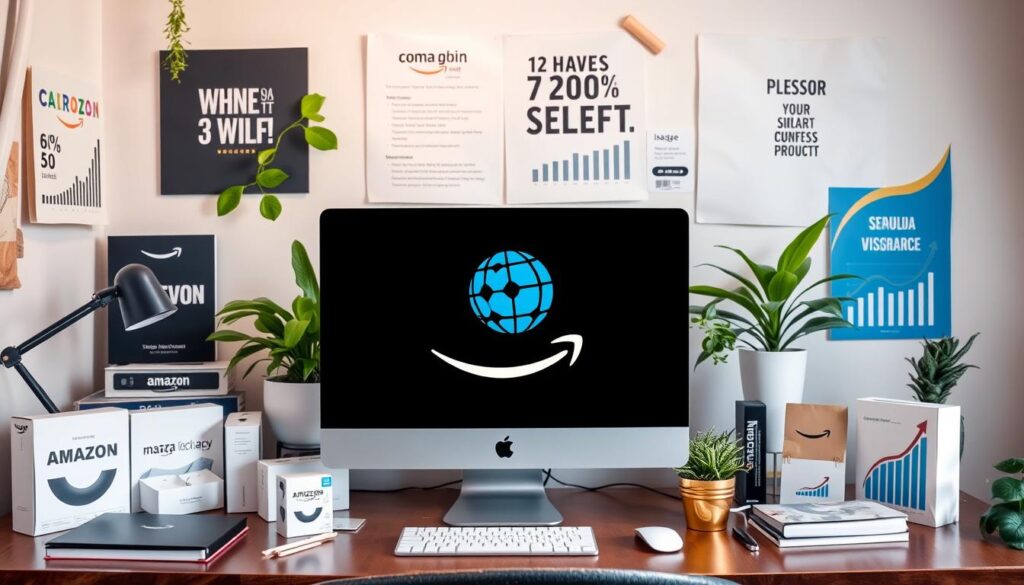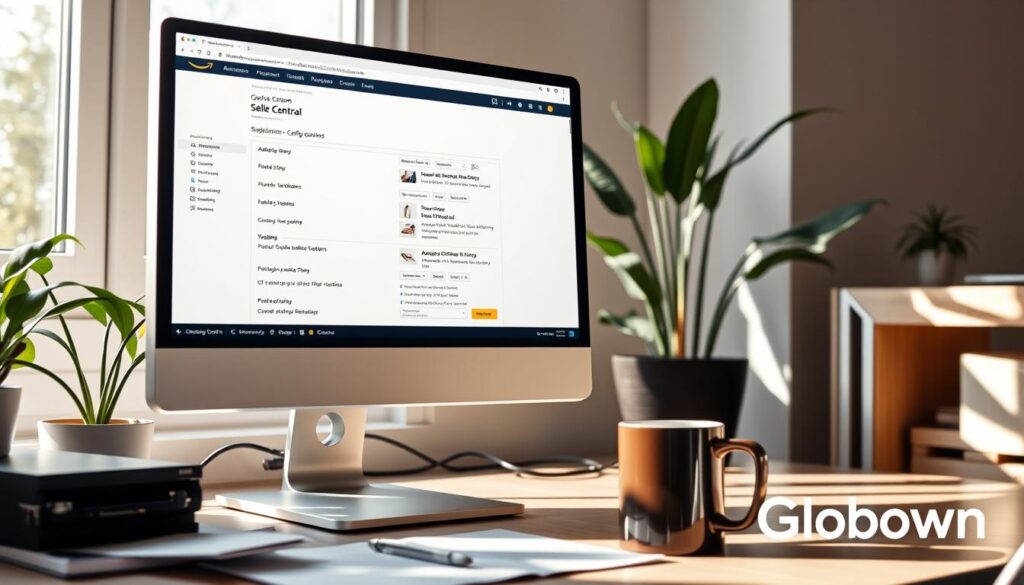Did you know over 200 million products are sold on Amazon every day? This huge e-commerce site is a treasure trove for those wanting to start an online business from home. It’s perfect for both newbies and seasoned entrepreneurs. Amazon lets you tap into millions of customers all over the world.

Key Takeaways
- Amazon offers two selling plans – the Individual plan ($0.99 per sale) and the Professional plan ($39.99 per month) – each with different tools and services.
- Sellers must register and create a Seller Central account, providing information such as a bank account, credit card, government ID, tax details, and phone number.
- In addition to the selling plan fee, Amazon collects a referral fee on each item sold and other potential selling fees may apply.
- Selling on Amazon from home can be a lucrative opportunity for both individuals and established businesses.
- The key to success is understanding the platform, optimizing your product listings, and providing exceptional customer service.
Choosing Your Amazon Selling Plan
Starting an Amazon business means picking a selling plan first. You have two main choices: the Amazon Individual selling plan and the Amazon Professional selling plan. Knowing the differences helps pick the right one for your business.
Individual vs. Professional Selling Plan
The Amazon Individual selling plan is for casual sellers or beginners. It costs $0.99 per sale, which is cheaper for those selling less. The Amazon Professional selling plan costs $39.99 a month but offers more tools for bigger businesses.
| Feature | Amazon Individual Selling Plan | Amazon Professional Selling Plan |
|---|---|---|
| Monthly Subscription Fee | $0.99 per sale | $39.99 per month |
| Access to Advanced Seller Tools | Limited | Full access |
| Ability to Sell in Additional Categories | Restricted | Unrestricted |
| Order Fulfillment Options | Merchant Fulfilled | Merchant Fulfilled, FBA |
Understanding Amazon Selling Fees
Amazon also takes a referral fee on each sale. This fee changes based on the product category and can be between 6% and 20% of the sale price. There are extra fees for services like Amazon Advertising and Fulfillment by Amazon (FBA). Knowing these Amazon selling costs is key to setting your prices and business strategy.

“Choosing the right Amazon selling plan is a crucial first step in building a successful online business. The decision should be based on your sales volume, product categories, and long-term growth plans.”
Setting Up Your Amazon Seller Account
Starting an Amazon seller account is an exciting first step towards building your online business. To get your seller central account setup and Amazon seller account configuration complete, you’ll need to follow a few key steps.
Creating Your Seller Central Account
The first task is to register for a Seller Central account on Amazon. You can use the email address from your existing Amazon account or a business email. You’ll need to provide your bank account details, a credit card, government-issued ID, tax information, and a phone number during registration.
Configuring Your Account Settings
- Set up your public seller profile, including your business name, location, and a brief description.
- Enter your payment and business information, such as your bank account and tax details.
- Configure your shipping and returns policies to ensure a smooth customer experience.
- Manage user permissions and access to your Seller Central account.
Properly configuring your Amazon seller account is crucial before you start listing and selling your products. Taking the time to set up your account settings will help you stay organized and provide a professional experience for your customers.

“The key to successful selling on Amazon is setting up your account correctly from the start.”
By following these steps to create your Amazon seller account and set up your Seller Central account, you’ll be well on your way to launching a thriving online business on the world’s largest e-commerce platform.
Enrolling Your Brand in Amazon Brand Registry
Protecting your brand is key for success on Amazon. The Amazon Brand Registry program helps a lot. It lets you control your product pages, use special tools, and keep your brand safe.
With Amazon Brand Registry, you can use brand content tools like A+ Content and Amazon Stores. These tools help you make your product pages stand out. You can add cool media, detailed descriptions, and charts to show what makes your products special.
The program also helps you fight against fake products and trademark issues. By registering your brand, you can report any problems. This keeps your brand safe on Amazon.
To start, you need a trademark from a government office. After you sign up, you get access to many tools. These tools help make your products more visible on Amazon.
Joining the Amazon Brand Registry is a smart move for your Amazon business. It helps you grow your brand, protect your ideas, and increase sales and loyalty.
“The Amazon Brand Registry program has been a game-changer for our brand. It has not only helped us protect our intellectual property but also allowed us to create more engaging and informative product detail pages that resonate with our customers.”
– Jane Doe, Founder of XYZ Brand
Optimizing Your Product Detail Pages
The product detail page is key to a successful Amazon business. It’s where customers find all they need to know about your products. By optimizing these details, you can boost your sales and improve your page’s visibility.
Mastering the Product Detail Page
The product detail page is the heart of your Amazon listings. It’s where you show off your products and give customers the info they need. Let’s look at the important parts that can make your listing stand out:
- Product Title: A catchy, keyword-rich title (up to 200 characters) is vital for getting noticed. Make sure it accurately describes your product and includes important keywords.
- High-Quality Images: Great images (at least 500×500 pixels) are crucial for showing off your products. Show different angles and uses to give a full view.
- Product Variations: If your product has different sizes, colors, or types, highlight these clearly. This makes it easy for customers to find what they need.
- Bullet Point Features: Use short, benefit-focused bullet points to highlight your product’s key features. This helps customers quickly see what you offer.
- Detailed Product Description: Write a compelling, detailed description that covers your product’s features and benefits. This is your chance to really sell your product and answer any questions customers might have.
- The “Buy Box” Offer: Make sure your product is priced right and eligible for the Amazon “Buy Box.” This can greatly increase your visibility and sales.
By optimizing these key elements, you’ll improve your Amazon listing and boost your sales.
| Key Element | Best Practices |
|---|---|
| Product Title | Up to 200 characters, keyword-rich, attention-grabbing |
| Images | High-resolution (at least 500×500 pixels), multiple angles, features, and usage scenarios |
| Product Variations | Clearly showcase different sizes, colors, or configurations |
| Bullet Point Features | Concise, benefit-driven, highlighting key product advantages |
| Product Description | Compelling, informative, addressing customer concerns and questions |
| “Buy Box” Offer | Competitively priced, eligible for the Amazon “Buy Box” |
By following these amazon product detail page best practices, you’ll optimize your Amazon listings and increase your sales.
“Optimizing your Amazon product detail pages is crucial for standing out in a crowded marketplace and convincing customers to choose your products.”
Enhancing Your Listings with Brand Content
As an Amazon seller, using the platform’s tools is key to show off your brand and products. You can use amazon shoppable videos, amazon a+ content, and amazon 3d models to make your listings stand out. These features help give customers a better shopping experience.
Shoppable Videos
Amazon shoppable videos are great for boosting sales and cutting down on returns. They can make sales jump by up to 9.7% and returns drop by over 40%. This is because they let customers see your products up close before buying.
A+ Content
Amazon brand content also includes A+ Content, which can increase sales by up to 20%. With A+ Content, you can add more product details, high-quality images, and comparison charts. This makes shopping more detailed and fun for customers.
3D Models and Virtual Try-On
Amazon also has amazon 3d models and amazon virtual try-on features. These can make customers more likely to buy, with 3D models doubling purchase rates. Virtual try-on tools also help by letting customers see how a product fits before buying.
By using these amazon brand content tools, you can make your product listings more engaging and informative. This can lead to more sales and happier customers on Amazon.
Listing and Selling Your Products
To sell your products on Amazon, knowing about product IDs and Global Trade Item Numbers (GTINs) is key. These identifiers help match your products with existing listings or create new ones.
Understanding Product IDs and GTINs
Amazon often uses the Universal Product Code (UPC) as the GTIN. But, ISBN, EAN, or JAN can also work. These IDs help Amazon organize your products well. This makes them easy to find for customers.
Matching or Creating New Product Listings
If your product is already listed on Amazon, you can link your offer to that page using the GTIN. This makes listing easier and keeps your product’s info up to date. But, if your product isn’t listed, you’ll need to create a new page and add your offer details.
When making a new listing, focus on making the title, description, images, and keywords appealing. Researching Amazon’s best practices for product detail pages is important. This helps your products stand out to buyers.
| Product ID | Description | Example |
|---|---|---|
| UPC (Universal Product Code) | The most common GTIN used on Amazon | 123456789012 |
| ISBN (International Standard Book Number) | Used for books and other publications | 978-0-306-40615-7 |
| EAN (European Article Number) | Used internationally, similar to UPC | 9780306406157 |
| JAN (Japanese Article Number) | Used in Japan, similar to UPC and EAN | 4988601123456 |
Understanding product IDs and GTINs is crucial. Mastering listing and selling on Amazon will help you succeed.
How to Start Online Business from Home with Amazon
Starting an e-commerce business from home is easier than ever, thanks to Amazon. Aspiring Amazon sellers have many business models to choose from. Each model offers unique chances to succeed online.
Choosing Your Amazon Business Model
Amazon offers several business models for entrepreneurs. You can sell products you find cheaper and resell them for profit. Or, you can list products without holding any inventory.
There’s also the option to create your own brand and products. This way, you can build a unique business.
Conducting Product Research
Finding the right products to sell is key. Tools like the AMZScout Product Database and AMZScout PRO Extension help a lot. They analyze product data and trends to find profitable items.
By studying market demands and sales, you can pick the best products for your store.
Finding Suppliers and Sourcing Products
Choosing your suppliers is important. Platforms like Alibaba are great for finding reliable suppliers. They help you get high-quality products for your Amazon store.
By picking the right business model, researching products well, and finding good suppliers, you’re set. You can start your Amazon business from home and enjoy the journey.
Fulfillment Options: FBA vs. FBM
As an Amazon seller, you have two main choices: Fulfillment by Amazon (FBA) and Fulfillment by Merchant (FBM). Knowing the benefits of each can help you pick the right path for your amazon fba, amazon fbm, and amazon fulfillment options.
The Benefits of Fulfillment by Amazon (FBA)
FBA is a favorite among Amazon sellers. By sending your stock to Amazon’s centers, you tap into their logistics and customer service. FBA sellers get many perks:
- Faster shipping for customers, with Amazon’s Prime delivery options
- More visibility and sales, as FBA products get priority in search results
- No hassle with order fulfillment, as Amazon handles it all
- Top-notch customer support, with Amazon’s famous service team
But, FBA comes with extra fees. You need to consider these costs when setting your prices. Sellers must think carefully if FBA is the best amazon fulfillment options for them.
| FBA Benefits | FBM Benefits |
|---|---|
| Faster shipping and Prime eligibility | Potentially lower fulfillment costs |
| More visibility and sales | Keep more control over inventory and logistics |
| Hassle-free order fulfillment | Flexibility to customize packaging and branding |
| Reliable customer support | Avoid FBA fees |
The choice between amazon fba and amazon fbm depends on your business needs, products, and logistics. Take time to compare both options to find the best amazon fulfillment options for your Amazon business.
Exploring New Opportunities and Niches
As an Amazon seller, it’s key to keep up with new trends. Amazon offers tools to find new markets and trends. This helps you grow your business.
Amazon Product Opportunity Explorer
The Amazon Product Opportunity Explorer uses data to find products in demand. It helps you find good product categories and niche markets. This tool gives you insights for choosing and finding products.
Amazon Business for B2B Customers
Amazon also serves business customers. These customers buy more and return less. By selling to Amazon B2B customers, you can reach more people and make more money.
Amazon Global Selling for International Expansion
Going global can really boost your business. The Amazon Global Selling program makes it easier. It helps you sell internationally with support and tools.
| Feature | Description |
|---|---|
| Amazon Product Opportunity Explorer | Analyzes customer data to uncover unmet demand and identify promising product categories |
| Amazon Business for B2B Customers | Provides access to a business-focused customer segment with higher order quantities and lower return rates |
| Amazon Global Selling | Simplifies the process of expanding your Amazon business to international markets |
Using Amazon’s tools, you can explore new opportunities and niches. This will help your online business grow and succeed.
Tools and Resources for Amazon Sellers
As an Amazon seller, you get a lot of help from the platform. You can manage and grow your business with tools like Seller Central and mobile apps. Amazon also offers educational programs to help you succeed.
Seller Central and Seller App
The amazon seller central is key for your business. It lets you list products, manage orders, and check reports. The amazon seller app is great for those on the move. It lets you do many tasks from your phone.
Selling Partner Appstore and Service Provider Network
Amazon also has the amazon selling partner appstore. It’s a place for third-party software to help your business. You can find tools for inventory management and advertising here. The amazon service provider network connects you with trusted service providers. They can help improve your product listings and marketing.
Seller University and New Seller Guide
Amazon has a lot of educational resources for sellers. The amazon seller university offers webinars and guides on many topics. The amazon new seller guide helps new sellers with support and incentives in the first 90 days.
Using these tools and resources can make your business better. You can improve your listings and stay competitive in the Amazon marketplace.
Conclusion
Starting an online business on Amazon can be exciting and rewarding. You can do it from home. By knowing the different Amazon selling plans and setting up your account, you can start your business.
Amazon offers many ways to sell, like Fulfillment by Amazon (FBA) and Fulfillment by Merchant (FBM). You can also sell to businesses or in international markets. With good product research and reliable suppliers, your business can grow and make money.
This guide shows how important it is to know Amazon, optimize your listings, and use its tools. With hard work, flexibility, and a focus on customer value, you can make your Amazon business thrive. It can match your dreams and goals.
FAQ
What are the Amazon selling plans and their differences?
Amazon has two selling plans. The Individual plan costs $0.99 per sale, while the Professional plan is $39.99 per month. The Individual plan is good for casual sellers. The Professional plan is better for businesses that sell a lot.
Amazon also takes a referral fee on each sale. Other tools and programs might cost extra.
How do I set up an Amazon Seller Central account?
First, you need to register and create a Seller Central account. You’ll need a bank account, credit card, government ID, tax info, and a phone number. It’s important to set up your account settings before you start selling.
What is Amazon Brand Registry and how can it benefit my business?
If you own a brand, Amazon Brand Registry can help. It gives you control over your product pages and access to free tools like A+ Content. It also offers brand protection and reporting options.
Brand Registry is free. It helps you link your products to your brand name and use Amazon’s brand management tools.
What are the key elements of an optimized Amazon product detail page?
Important elements include the product title, high-quality images, and product variations. You also need bullet point features, the “Buy Box” offer, and a detailed product description. Making these elements better can help your product sell more.
What are some tools and features Amazon provides to enhance product listings?
Amazon has tools to make your brand and products stand out. You can use shoppable videos, A+ Content, and 3D models. These can boost sales and improve customer experience.
How do I list products on Amazon and what are GTINs?
To list products, you need to know about product IDs, or GTINs. UPCs are the most common GTIN. But ISBN, EAN, or JAN can also be used.
If your product is already on Amazon, you can match your offer to its page. If not, you’ll need to create a new page and add your offer information.
What are the different business models for selling on Amazon?
Sellers can choose from retail/online arbitrage, dropshipping, wholesale, and private labeling. Finding profitable products is key. Tools like AMZScout can help analyze data to find the best products.
What are the differences between Fulfillment by Amazon (FBA) and Fulfillment by Merchant (FBM)?
FBA sellers send their inventory to Amazon’s centers. Amazon handles everything. FBA sellers get faster shipping and more visibility, but pay fees.
FBM sellers handle everything themselves. It’s cheaper but requires more work.
What other tools and resources does Amazon provide to help sellers grow their business?
Amazon offers many tools and resources. There’s Seller Central, the Amazon Seller app, and the Selling Partner Appstore. You can also find educational content and vetted service providers.

